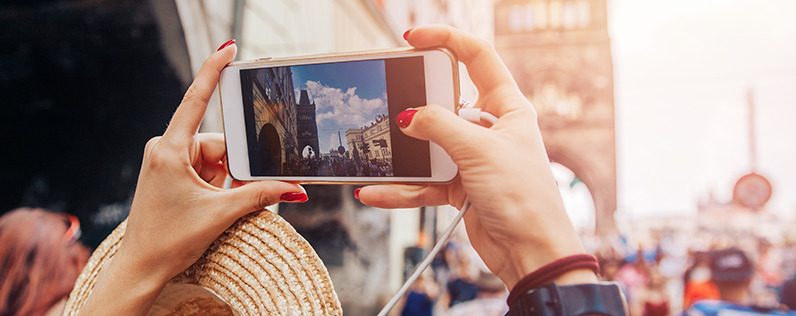
When you’re promoting a travel business, social media seems like a natural fit. After all, most people love to find images of great vacation spots in their feed so they can daydream about future adventures.
But how does that drive sales for your business? Which channels should you be posting on and what should you post? In short, how can you use social media to market your travel business?
Luckily, there are few guidelines you can follow to simplify your social media approach and get the most new business from your online presence.
Follow these steps to create a travel social media strategy that will connect you with your audience and generate more sales.
1. Choose your primary social media channel
It’s a good idea to choose just one or two social media channels to focus on. You can always add more later, as you build a library of material to share. There are two approaches to choosing your primary social media.
Choose the channel that feels like your personal social media “home.”
If you love to browse Pinterest, you’ll have a natural sense of what makes a pin appealing. If you belong to dozens of travel groups on Facebook, you probably have a good sense of what inspires Facebook users to take a trip. If you work where you’re most comfortable, your learning curve will be less steep and you’ll feel more confident.
Target a social media channel based on the customers you’re trying to reach.
The more you know about your target customer, the easier it is to know where to find them online. The channel you choose should make sense in terms of what you’re offering as well — for instance, business and professional travel is a natural pairing for LinkedIn, while a yoga retreat may be a better fit for Instagram.
2. Know your channels
If you’re not sure who is using each platform or what to post on each one, here’s a quick rundown of the different characteristics of major social media channels.
- Demographics: 75% of women and 63% of men use Facebook. It’s gaining popularity with older people, and teens are less likely to use it these days.
- Type of media: You can share images, stories, links, and videos.
- Best way to use the platform: Create short, highly visual posts and try to find ways to get conversations going with your followers.
- Demographics: 37% of adults use Instagram. Compared to Facebook, its audience skews younger (75% of 18- to 24-year-olds use Instagram) and is more likely to be Black or Hispanic.
- Type of media: Photos, very short (less than one minute) videos. Only one link can be added, and it’s in your profile.
- Best way to use the platform: Post stunning photos and videos frequently. Use hashtags to attract new audiences.
- Demographics: 24% of men and 31% of women use Twitter. Twitter users are more likely to be young.
- Type of media: Very brief, text-based posts, photos, and links.
- Best way to use the platform: Think in terms of connection: Retweet, comment, and engage with others.
- Demographics: 29% of men and 24% of women use LinkedIn. It is primarily a professional and business networking platform.
- Type of media: The most popular posts are studies, testimonials, videos, e-books, and reports.
- Best way to use the platform: Use LinkedIn to talk about the business side of what you’re doing or to connect with business travelers.
YouTube
- Demographics: 78% of men and 68% of women use YouTube. Although many users are young, it’s popular with older users as well.
- Type of media: Videos and community posts.
- Best way to use the platform: Create engaging, useful videos and encourage people to follow your channel.
- Demographics: 42% of women and 15% of men use Pinterest.
- Type of media: Links anchored by a strong graphic or photo.
- Best way to use the platform: Create graphic pins that link to your website and share them on group boards.
What to share: Awareness, engagement, action
Once you’ve chosen one or two social media channels, you’re faced with the dilemma of what to post. There are three types of posts that are best for promoting your business, and you should create posts from all three categories regularly.
Awareness
These are posts focused on letting people know who you are and what you do.
Use as much visual storytelling as possible to create an accurate and appealing vision of what your business offers people. Destination shots are always popular, but also look for ways to showcase your unique style — whether that’s luxury, adventure, cultural experiences, or something else.
Engagement
This type of content helps you bond with your audience and get a conversation going. Survey your audience’s opinions. Share travel humor, advice, articles, and other conversation-starters. When people engage with you, be sure to respond and try to keep a conversation flowing.
Action
Be sure to include posts that encourage your audience to take a specific action, such as clicking through to your website or signing up for your email list. Let people know about specials, events, and offers. Promote a free e-book or packing list and “gate” the content by asking for their email address before they can download it.
Be succinct
People who are scrolling through social media aren’t prepared to invest big chunks of time in watching long videos or reading six-paragraph posts.
Studies show that most people won’t watch more than two minutes of a video on Facebook or YouTube. Put a call to action in the first 10 seconds of your video in case people don’t watch more.
For text-based posts, stick to a sentence or two. Use graphics to help make your points and tell your stories.
Develop synergies
If you add more social channels later, look for ways to adapt and reuse your content across platforms to save time. While you don’t want to post the exact same thing across all social media channels, you can find ways to make your content work together.

Crop and resize images
Choose a terrific image of your guests enjoying a past trip. Share it on Facebook, with a short story about those guests and a quote from their testimonial — and tag them, they might share it too!
Create a square version of the image that includes their quote (canva.com is a great free tool for this) and share it on Instagram with a set of hashtags and an invitation to check out the trip at the link in your profile.
Adapt the image with the quote into a vertical graphic and put it on Pinterest, with a link to details about the trip.
Embed and trim videos
If you create a two-minute video about a trip, you can upload it to YouTube and promote it to your followers. Then embed the YouTube video in your blog and share the post to LinkedIn.
Create a 30-second version of the clip to share on Facebook, Instagram, and Twitter with a discussion question.
Break up text
Suppose you’ve written or purchased a 1,000-word blog post filled with travel tips. Besides sharing links to that content, you could also share each tip as an individual post on Facebook or Twitter, or embed the tips into graphics to share on Instagram and Pinterest.
You could also make a series of short videos of yourself explaining a few related tips and share the videos on YouTube, Instagram, Twitter, or Facebook.
Your travel social media strategy
Creating a social media marketing strategy for your travel or tourism business can be boiled down to a few steps. First, choose the social channel that you and your target audience are most familiar with. Then, create posts that build awareness, encourage engagement, and invite action.
Keep your posts brief and visual. As your social media presence grows, look for ways to adapt the same materials for different channels to save time and increase your results.
You can learn more about using online marketing and social media to promote your travel or tourism business in our free digital guide, The Download.




